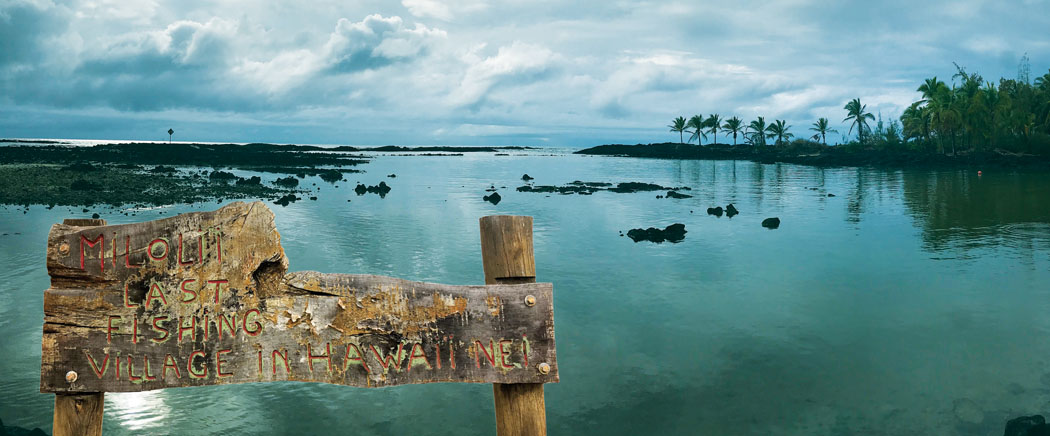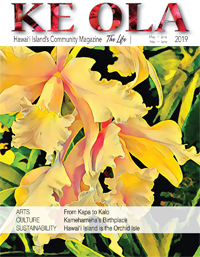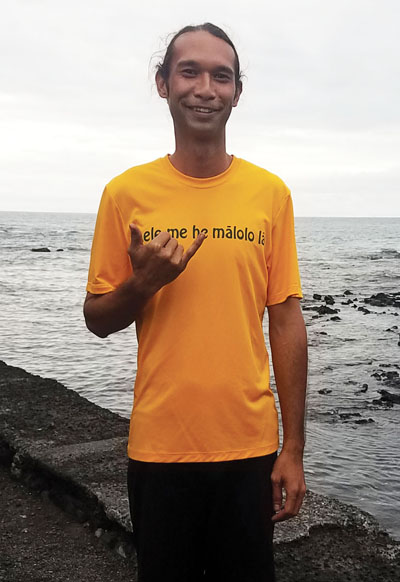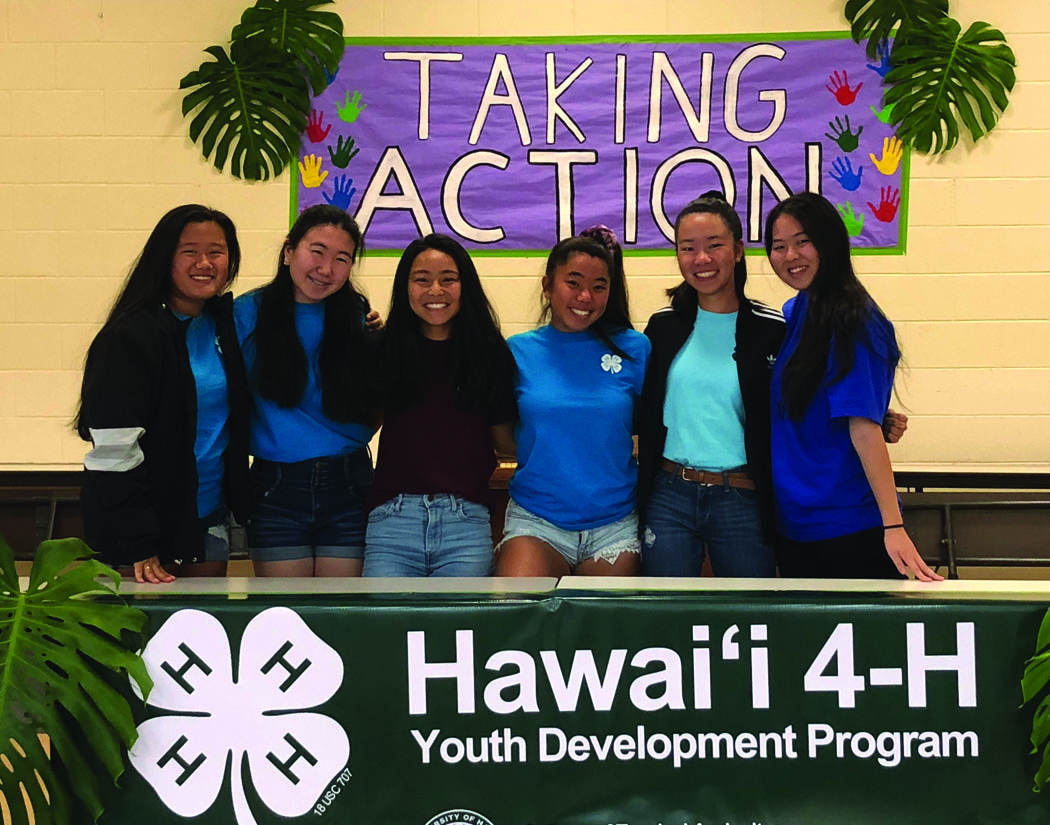
“Miloli‘i aku nei au lā…At Miloli‘i there was I…”

By Marcia Timboy
The opening line of this famous mele (song) about one’s huaka‘i (journey) from Miloli‘i to seek experiences in bigger cities, was composed by John Makuakane in the 1930s. Over the years many kama‘āina (residents) of Miloli‘i leave the village for educational or other opportunities. With Miloli‘i in their hearts, they always find a way to return.
Located in the South Kona district of Hawai‘i Island, Miloli‘i remains the most traditional fishing village in Hawai‘i. Miloli‘i families have been fishing offshore and near-shore waters for generations. There are two differing translations of Miloli‘i: one is “fine twist,” in reference to the excellent sennit from the olonā bark to make fine cordage and highly valued fishing nets (Nolan 1981); the other, “small swirling,” denotes the many ocean currents that flow past the village (Pukui 1981).
Cultural and Natural History

The history of human settlement in the Miloli‘i-Ho‘opūloa area extends to the first millennium. To the north of the current community at Alika Bay are visible remains of a hōlua slide and several ancient house sites. To the south, at Honomalino Bay, are more ancient house sites. These extensive sites suggest the area was once one of sizeable human activity. The community’s recorded history is tied closely to the arrival of New England missionaries in the early 19th century. They occasionally made the long journey from Kailua-Kona to preach and teach, and gathered the first congregation together in Miloli‘i.
These missionaries conducted the first complete census in Hawai‘i in 1831, and again in 1835. The 1835 census included the villages of Miloli‘i and Ho‘opūloa, under the district name of “Kapalilua” with a total of 1,406 people recorded.
By 1883, with the pervading acceptance of Christianity, the size of the congregation had grown to warrant the Miloli‘i church, Hau‘oli Kamana‘o. The church still stands, and though moved from its original site, it provides a link to the past for the community members. The resident populations at Miloli‘i and Ho‘opūloa remained constant throughout the latter 19th century and declined slightly at the turn of the 20th century. On the morning of April 18, 1926, life at Ho‘opūloa was altered forever as lava from Mauna Loa’s Pu‘u o Ke‘oke‘o gradually approached and completely covered the small coastal fishing village. Many of the families, lacking alternative shelter, moved a quarter mile down the coast to Miloli‘i. They built new homes mostly on government land, while other residents moved mauka (upland) and found shelter as best they could.
Legal Tenancy, Indigenous Land Rights, and Historic Significance
Over the years, residents of Miloli‘i have continued to occupy the land. Their right to do so has never been questioned, but legal tenancy or ownership had never been conferred. In 1931 the territorial governor set aside the area as a public park under the control of the county government (Executive Order 473). Under the park provision the governor gave the county full authority to create a “Hawaiian Village” at Miloli‘i. The county had the village subdivided into house lots in 1941. Requests were submitted to occupy the house lots between 1943 and 1954. While some of the house lots were awarded, residents did not receive title to them. In 1968 Governor Burns canceled Executive Order 473 and the land reverted to the Department of Land and Natural Resources (DLNR), intended to be a land swap with the Department of Hawaiian Homelands (DHHL). However, the exchange did not take place, as DHHL did not have the legal means of directly leasing lands to Miloli‘i residents.
A survey was conducted in the Miloli‘i area between 1973 and 1974 to identify sites and structures for the Hawai‘i Register of Historic Places. A number of churches and characteristic structures were acknowledged, and many still remain, including:
- The Magoon House—a unique example of a small wooden “Kona House” built in the late 19th century. Elvis Presley stayed in this house in the 1950s, when Girls, Girls, Girls was filmed in Miloli‘i.
- St. Peter’s Catholic Church—this structure was built in 1932 by Father Steffen to replace an earlier St. Peterʻs destroyed by the 1926 lava flow.
- Hau‘oli Kamana‘o Congregational Church—an example of architectural style with historical significance. Built in 1865 under the direction of the Rev. John D. Paris, it’s an excellent example of early missionary wood construction. It is made famous by the song “Lā ‘Elima.”
- Apo House—an example of typical architecture of older houses in Miloli‘i Village.
- Miloli‘i School—an example of the wooden frame architectural style popular at that time.

Its Isolation is Its Protection
Miloli‘i is situated five miles downslope from Māmalahoa Highway at the end of a narrow winding road where few tourists go. Arriving at sea level, there is a scattering of houses on a stark lava plain, where the village’s approximately 400 residents live. The water is on catchment system, and there’s no electricity other than some solar here and there. Much of that is by choice. Miloli‘i could have had electricity, but the kūpuna (elders) fought to keep it out, hoping to preserve this mostly Native Hawaiian community from changes modernity has brought to the rest of the Hawaiian Islands. That protectiveness is partly why Miloli‘i has a reputation for being unwelcoming—a place where strangers wandering around with a camera might be reproached with a gruff, “Eh! No take pitcha!” A hand-carved wooden sign in the middle of the village proclaims, “Miloli‘i: last fishing village in Hawai‘i Nei,” and many who live there want to keep it that way.
Ho‘i Hou—Return

William Mae-Huihui was born and raised in Miloli‘i, until he moved to O‘ahu at nine years old. “Willie Mae” returned to Miloli‘i in 2010, after graduating with a degree in liberal arts from Leeward Community College. An innate affinity towards marine management compelled him to become immersed in the iconic and traditional fishing practice of his Miloli‘i ancestors.
“My [paternal] grandma, who is connected to the Kahele ‘ohana, and my mom’s side, the Makuakane ‘ohana, have resided in Miloli‘i for generations. We are also related to the Grace and Apo ‘ohana. I came back [to Miloli‘i] after I graduated from Radford High, and stayed for a few years. My mom asked if I would move back [to O‘ahu] and go to college. After receiving a liberal arts degree, I had a calling to come home. I started learning my aunty’s style of fishing, which was great for commercial fishing, but I was concerned about its environmental impact. I then studied [bottom and pelagic fish] spawning and feeding habits. I blended the two, and now with the help of Uncle Mac [Poepoe, of Moloka‘i] I can understand the reasons behind the seasons of harvest times and rest times. I also remember my grandpa saying it wasn’t good to go out when the milo [swirling currents] occur…the reef fish are spawning the same time that the milo happens here. Matching up with what our kūpuna say and why, is the most rewarding with the Mohala no Konohiki program that I am a part of.”
Also born and raised in Miloli‘i Village, Kaimi N. Kaupiko is from a long line of kama‘āina going seven generations back. His kūpuna were the first deacons of Hau‘oli Kamana‘o Congregational Church. With strong and deep ties to the community, Kaimi returned to Miloli‘i eight years ago, after graduating with an MBA from the University of Hawai‘i at Mānoa. He was an instrumental contributor in the Conservation International-sponsored Miloli‘i ‘Ōpelu Project, which utilized an innovative method of fishing, combining modern science, and the understanding of ocean currents and fish lifecycle patterns of traditional Hawaiian practice. With the passing of kūpuna, traditional methods of fishing and the intergenerational transfer of knowledge has not taken place. As only a few traditional ‘ōpelu practitioners are left in the village, such projects aim to revive these methods, merging with modern science to educate the community’s youth, and improve the stewardship of these marine and coastal resources so precious and prevalent on the South Kona coastline.
As a full-time educator, Kaimi teaches the community’s youth coastal management, through Pua o Kala (an online school). The school’s multi-media programs have been featured on PBS’ Hiki No channel, and YouTube.
“Miloli‘i lifestyle is about sustainability, to live off the land. I grew up fishing makai [seaside], and picking coffee mauka. Our community is isolated, and we survive and thrive by keeping the traditions alive through respect, cooperation, and malama—take care of place, place takes care of you.”

Over the years Kaimi has seen the area’s natural resources depleted and its environment burdened with encroaching development, interlopers, and climate change. He sees that the youth of today do not have the same discipline and structure of previous generations. By revitalizing a sense of ‘ohana and community values, Kaimi and his contemporaries hope to preserve, perpetuate, and instill kuleana (responsibility) of Miloli‘i’s culture and traditions for future generations. Part of the community’s master plan is to house cultural education programming, and a K-12 school at the Miloli‘i Community Center, once construction is completed.
Ho‘i hou…as kama‘āina o Miloli‘i return to the cherished village, they bring with them acquired education and experiences from nā huaka‘i. The kuleana they take on to preserve, protect, and perpetuate the Miloli‘i lifestyle and its ‘ike (knowledge) stems from a deep aloha and generational sense of place. ❖
Miloli‘i
By John Makuakane
| Miloli‘i aku nei au lā I ke kau ‘ēkake lā Nuha i ke alanuiWaikīkī aku nei au lā I ke kau ‘elepani lā Ihu peleleuCalafrisco aku nei au lā I ke kau mokulele lā A lewa i ka lewa Honolulu aku nei au lā Ha‘ina ‘ia mai ka puana la |
At Miloli‘i, there was I As I got on the donkey It is stubborn on the roadAt Waikīkī, there was I As I got on the elephant It swings its trunkAt San Francisco, there was I I boarded the plane It dips from side to side At Honolulu, there I was Thus ends my song |
For more information:
paaponomilolii.org
equatorinitiative.org/2017/08/03/mohala-na-konohiki-developing-the-next-generation-of-ocean-stewards-and-fisheries-managers/
youtu.be/vIbfMTiOGDQ
vimeo.com/20135024
vimeo.com/202257896


